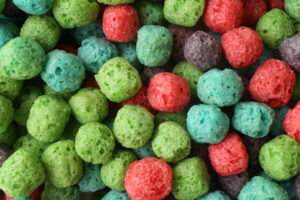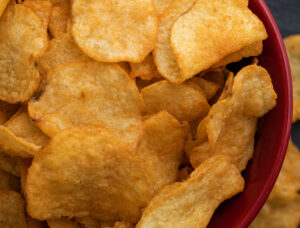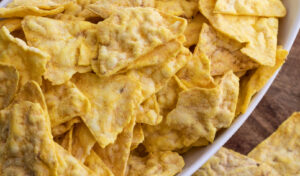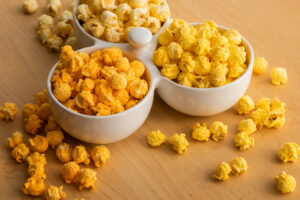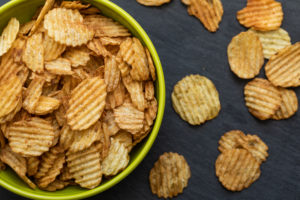A snack piece is such a unique, whole, and unitary element, that it takes effort to imagine it deconstructed. But it can be as simple or complex as the food designer decides it to be. In fact, as with many food products, snacks can be considered systems where numerous elements are placed together, interacting to give the consumer a holistic food experience that involves all the senses.
Since snacks are defined more by how they are consumed (a small bite between meals) rather than how they are made, the production of a snack product can involve a variety of different methods: like baking, frying, extruding, coating, and many others. They can also overlap with other food categories like confections, meats, dairy, cereals, or bakery products. And therefore, the different ways to color to snacks products are as varied as the formats they may adopt. We’ll go through some of the options to add natural colors to your snack products below.
Sweet Bars & Bites
First, we’ll look at sweet snacks. Cereal bars, for example, generally consist of the amalgamation and shaping of diverse, long shelf-life ingredients, like nuts, legumes, and puffed or extruded cereals, held together with the aid of a sticky syrup. The blend may also include other ingredients like candy inclusions, or healthier options like dietary fiber, whole grains, or dehydrated fruit. Icings or chocolate coatings can also be added for decoration purposes.
With so many ingredients there are a variety of options to impart color – But is it best to color the extruded pieces, the syrup, the inclusions, or the chocolate or icing decorations?
The answer: it all depends on the visual effect you want to achieve, the stability of the color you are using, and the extent of your control over the processes. Do you manufacture the extruded pieces, or do you buy them and formulate the finished bars? Is your factory better suited for handling dry blends, or can you make liquid dilutions to color the syrup, icing or fatty coatings? Do you want a subtle hint of color but still show the wholesomeness of the cereals and grains? Or do you prefer bold and vibrant colors to stand out in your product?
The images below show a few examples of how adding natural colors to different portions of the snack affect the appearance of the overall product.

Savory Snacks
Another example is with savory snacks: chips, tortillas, puffed pieces, salted and seasoned, or even batter enrobed nuts. Again, the decision of where to add the color will depend on both aesthetical and technical criteria.
Potato chips or crisps (depending on which the side of the pond we’re on), are generally fried, which results in what is called ‘tack’, – an inherent stickiness due to the thin layer of oil that is left in its surface. These types of snacks are better colored with a dry seasoning blend because the powders easily stick to the surface. Low intensity plated colors, like our Vibrant™ line, give the most reliable and consistent result, as seen below.
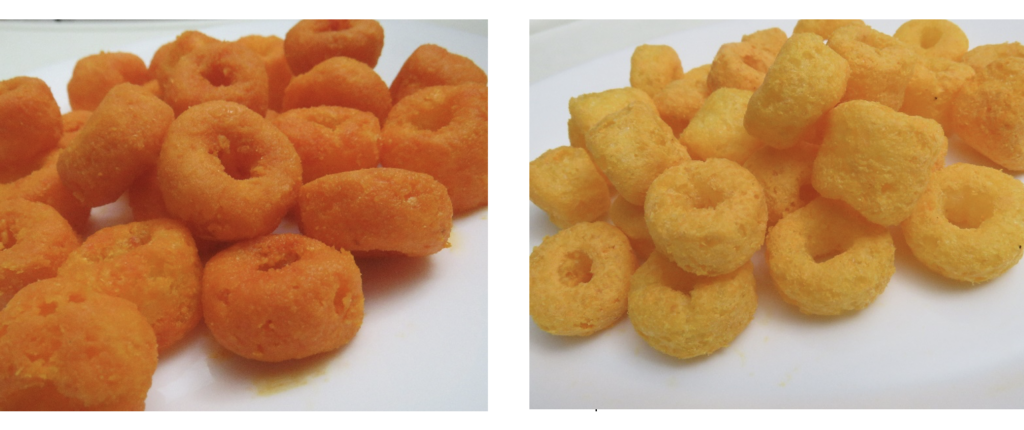
Tortilla chips, from corn or other flour, can be colored via the dough itself for a uniform look, or if fried, can also be colored using the powdered seasoning method, mentioned above. If coloring the dough, it’s often best to use water soluble colors to prevent the color from leaching into the frying oil while they cook. And be sure to choose heat stable colors for the best results.
Baked or extruded goods, like cheese puffs and crackers, do not have tack and therefore are better colored through the oil slurry along with the salt, seasonings, then sprayed onto the surface of the snacks. While it has generally been common to use colors in the form of artificial lakes for the snack coating finishes, there are plenty of natural colors that can achieve the same look while providing cleaner labelling options.
Natural oil soluble and oil dispersible colors have brilliant shades that can be customized to each unique snack, and are perfectly compatible with oil slurry formulations, providing an excellent coating effect and, better yet, a simple label with ingredients consumers know and trust like paprika, annatto, and turmeric. The images below show the vibrant shades you can achieve with oil soluble colors in these applications

While these are just a few examples of ways to add color to snacks. These can be as creative and varied as the world of snacks, but rest assured that our team of color scientist is prepared to help you with all the challenges your imagination can pose. Contact us with your snack questions or get started with a natural colors sample kit for snacks.

